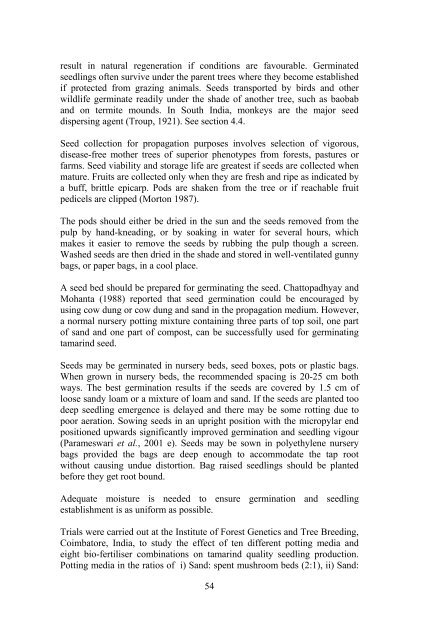Tamarind monograph.pdf - Crops for the Future
Tamarind monograph.pdf - Crops for the Future
Tamarind monograph.pdf - Crops for the Future
Create successful ePaper yourself
Turn your PDF publications into a flip-book with our unique Google optimized e-Paper software.
esult in natural regeneration if conditions are favourable. Germinated<br />
seedlings often survive under <strong>the</strong> parent trees where <strong>the</strong>y become established<br />
if protected from grazing animals. Seeds transported by birds and o<strong>the</strong>r<br />
wildlife germinate readily under <strong>the</strong> shade of ano<strong>the</strong>r tree, such as baobab<br />
and on termite mounds. In South India, monkeys are <strong>the</strong> major seed<br />
dispersing agent (Troup, 1921). See section 4.4.<br />
Seed collection <strong>for</strong> propagation purposes involves selection of vigorous,<br />
disease-free mo<strong>the</strong>r trees of superior phenotypes from <strong>for</strong>ests, pastures or<br />
farms. Seed viability and storage life are greatest if seeds are collected when<br />
mature. Fruits are collected only when <strong>the</strong>y are fresh and ripe as indicated by<br />
a buff, brittle epicarp. Pods are shaken from <strong>the</strong> tree or if reachable fruit<br />
pedicels are clipped (Morton 1987).<br />
The pods should ei<strong>the</strong>r be dried in <strong>the</strong> sun and <strong>the</strong> seeds removed from <strong>the</strong><br />
pulp by hand-kneading, or by soaking in water <strong>for</strong> several hours, which<br />
makes it easier to remove <strong>the</strong> seeds by rubbing <strong>the</strong> pulp though a screen.<br />
Washed seeds are <strong>the</strong>n dried in <strong>the</strong> shade and stored in well-ventilated gunny<br />
bags, or paper bags, in a cool place.<br />
A seed bed should be prepared <strong>for</strong> germinating <strong>the</strong> seed. Chattopadhyay and<br />
Mohanta (1988) reported that seed germination could be encouraged by<br />
using cow dung or cow dung and sand in <strong>the</strong> propagation medium. However,<br />
a normal nursery potting mixture containing three parts of top soil, one part<br />
of sand and one part of compost, can be successfully used <strong>for</strong> germinating<br />
tamarind seed.<br />
Seeds may be germinated in nursery beds, seed boxes, pots or plastic bags.<br />
When grown in nursery beds, <strong>the</strong> recommended spacing is 20-25 cm both<br />
ways. The best germination results if <strong>the</strong> seeds are covered by 1.5 cm of<br />
loose sandy loam or a mixture of loam and sand. If <strong>the</strong> seeds are planted too<br />
deep seedling emergence is delayed and <strong>the</strong>re may be some rotting due to<br />
poor aeration. Sowing seeds in an upright position with <strong>the</strong> micropylar end<br />
positioned upwards significantly improved germination and seedling vigour<br />
(Parameswari et al., 2001 e). Seeds may be sown in polyethylene nursery<br />
bags provided <strong>the</strong> bags are deep enough to accommodate <strong>the</strong> tap root<br />
without causing undue distortion. Bag raised seedlings should be planted<br />
be<strong>for</strong>e <strong>the</strong>y get root bound.<br />
Adequate moisture is needed to ensure germination and seedling<br />
establishment is as uni<strong>for</strong>m as possible.<br />
Trials were carried out at <strong>the</strong> Institute of Forest Genetics and Tree Breeding,<br />
Coimbatore, India, to study <strong>the</strong> effect of ten different potting media and<br />
eight bio-fertiliser combinations on tamarind quality seedling production.<br />
Potting media in <strong>the</strong> ratios of i) Sand: spent mushroom beds (2:1), ii) Sand:<br />
54

















